Tipularia discolor, cranefly orchid, is an uncommon and unusual native perennial herbaceous plant that its photosynthesis time does not overlap with the bloom time.
Flowers
Inflorescence/Flower cluster:


Individual Flower:
The Tipularia discolor plant has small inconspicuous flowers that are about half inch across and are a pale slightly transparent greenish/reddish color. As seen in the photos above, the flowers are attached to the stem with a pedicel which looks longer because of the long ovary that is behind the petals. Each flower has a even longer spur that can be nearly an inch long giving the inflorescence an untidy look. (See photos above).
If you look at the individual flowers, you will easily notice it does not look like a traditional orchid flower. Most orchid flowers have right-left symmetry (bilateral). One usually finds that the right and left sides are mirror images. That is not the case for Tipularia discolor. The top (dorsal) sepal is tilted to one side. One of the side (lateral) petals is tilted so that it almost overlaps the side (lateral) sepal on the same side. These asymmetrical features are seen in the photos below. The column in most orchids faces down over the lip, however, for the cranefly orchid, the column is slightly twisted to the left or right.
Interestingly, of all the North American orchids, only Tipularia discolor exhibits this asymmetry. There are only two other Tipularia species and they are in Asia and they exhibit bilateral symmetry.
Like all orchids, Tipularia discolor has 3 sepals and 3 petals. The specialized petal - the lip - here is 3 parted with a long spur extending from the back. The opening is in the center. The column is the reproductive structure with both male and female parts.
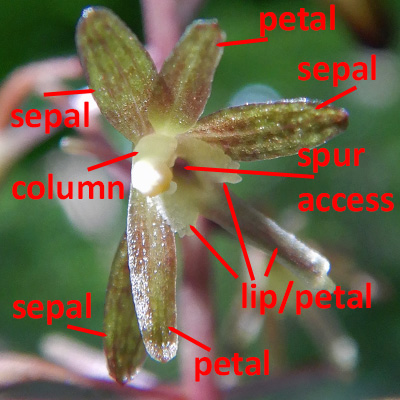
Here is a closer view of the column. At the tip of the column is the anther. The yellow pollen is encased in sacs called pollinia. There are 4 pollinia arranged as 2 pairs. The pollinia are encased in an anther cap. The pollinia and its associate parts, together is called a pollinaria. Beneath the anther, is the stigmatic cavity with a sticky surface.
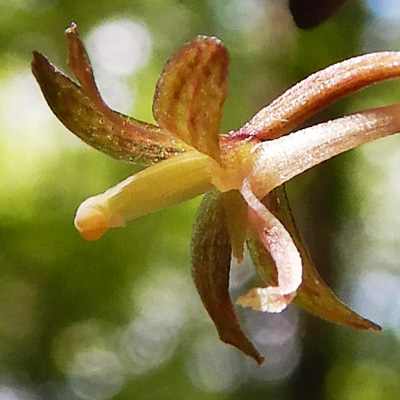
Below are two close ups. Each flower is oriented with the stem vertical. They are tilted in the opposite directions. There is a pollen sac in the stigmatic cavity in the second photo.
I was not able to identify the protruding structure at the base of the anther.
If a viewer could shed some light on the structures, please contact me.
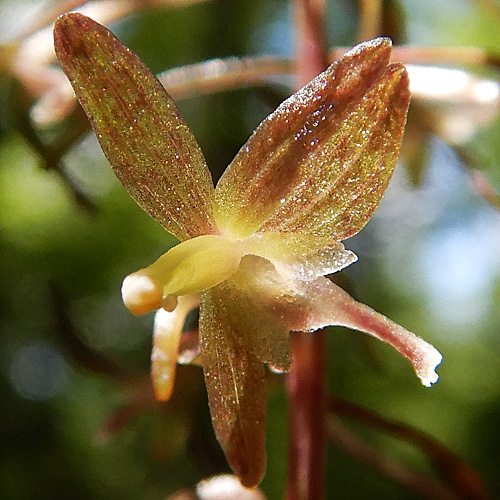
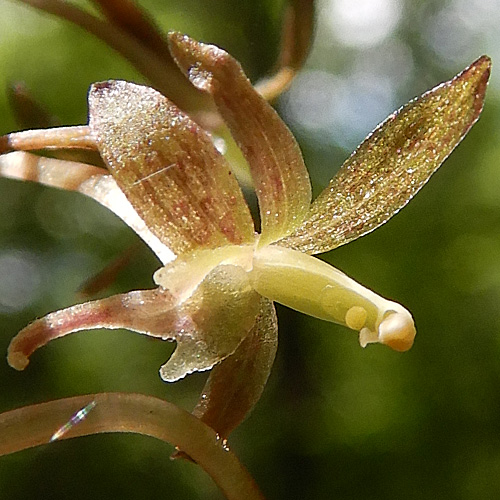
The spur here is seen extending from base of the lip. The spur is half filled with nectar.
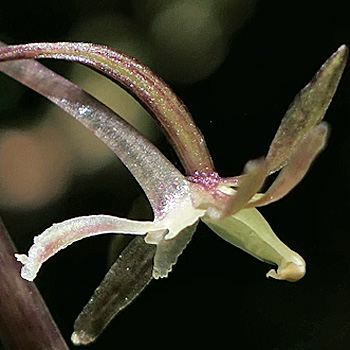
The anther has been removed maybe by a visiting insect. Some pollinia are deposited on to the stigmatic cavity
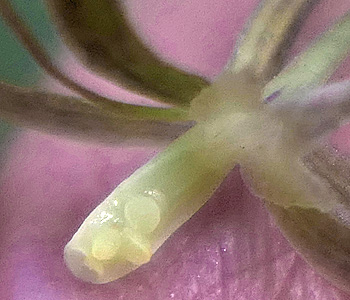
Buds were formed by July 31. Note that the spur is already a good size. Flowers were open the first or second week in August.

Fruit formation is starting. The ovary is behind the sepals & petals (inferior ovary) and is beginning to enlarge.
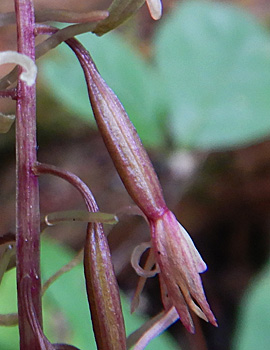
Fruit: The seed capsules each contain many tiny seeds.
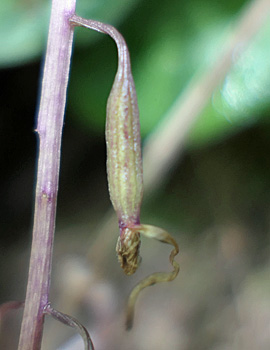
Pollination
Tipularia discolor, cranefly orchid, is pollinated by noctuid moths. The flower provides nectar in its spur as reward. As the moth pushes further into the flower to get nectar it's eye makes contact with the anther. Either the right eye or left eye picks up the pollen depending on the twist of the column. The pollen like other orchids is packed into sacs called pollinia. This anther package that the moth picks up includes not only the pollinia, but the anther cap (covering), and a sticky structure that attaches to the moth as well as other structures. The moth can then deliver this package to another flower for pollination.
When a moth picks up the anther package, it can also deliver the package to the stigmatic cavity of the same plant. That would result in self-pollination. It has been shown that manual self-pollinating a plant produces viable seeds.
To reduce the likelihood of self-pollination, the cranefly orchid uses a technique called anther cap retention. Usually in most orchids, the anther cap falls off immediately when insects pick up the pollinia. However, in the cranefly orchid, the cap remains on the pollinia for a period of time so that its pollinia cannot self-pollinate. Studies showed the cap retention times to be between 8 to 110 minutes. The anther cap prevents self-pollination. However, when the anther cap falls off off of the pollinia package, the pollinia are then available to pollinate another flower.
Leaves
The cranefly orchid leaf is green or green with purple on the upper surface, and deep purple beneath. In the fall after the plant has bloomed, a leaf emerges from a corm (vertical, fleshy, underground stem for storage of food) and the leaf persists through the winter. It will wither and be gone by the time the flower stem appears in summer. There is a single leaf per plant. The leaves are up to 3 inches long and lie almost flat on the ground. You need to remember the location of the leaves in order to find the flowers in summer. Plants with large leaves are more likely to produce flowers.
The leaf photos were taken early April and are a bit weather beaten. They stand out against the brown leaf litter. When we went back in the beginning of August to see the flowers the area was so different - the canopy was filled in, the shrub understory had leafed out and the herbaecous plants had also leafed out. It was hard to find the plant in the dim light! Studies have shown that the leaves have taken advantage of the sunniest time of the year for the plant on the ground to photosynthesize and the flowers bloom when the amount of light reaching the plant is lowest.

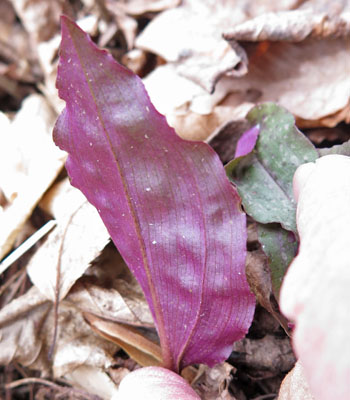


Plant - Habitat
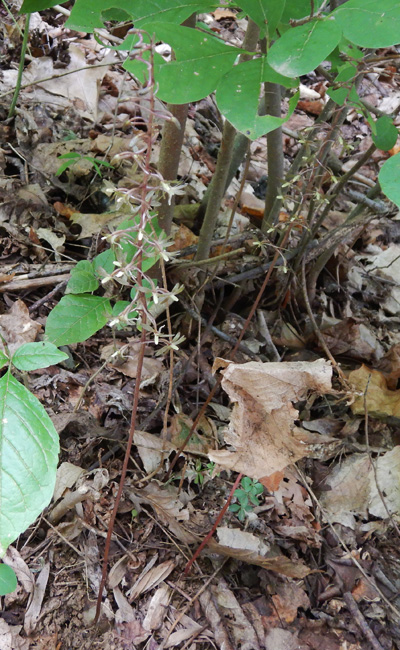
The plant produces a single erect stem in the summer that grows to 15 to 20 inches and is smooth and without leaves. At the top of the stem is the raceme of flowers. If you look hard at the photo to the left, the top of the raceme, the flowers are still in the bud stage.
The flowering stem originates from a corm that produced the leaf earlier. Roots emerge from the bottom of the corm. The corm forms offshoots so the plant reproduces vegetatively. The plant relies heavily on vegetative reproduction.
A plant may not bloom every year depending on the health of the corm. Producing flowers and seeds is expensive for the plant/corm. Leaf herbivory prevents the plant from creating food in the corm for storage. With very few green leaves available in the winter months, these leaves would be attractive to some wildlife like deer. Deer have also been known to eat the stem with the fruits.
Tipularia discolor in NJ produces a single leaf in late fall that over-winters and dies in spring before the plant blooms in the late summer.
Interestingly, the plant blooms earlier in the northern part of its range than in the southern part of its range: June (north)--Sept. (south). In NJ, we've seen it start blooming as early as 8/6. In NC, we've seen it in bloom as late as 8/26. In iNaturalist.org, flowering observations were still in August for Florida. Observations in bloom in July were recorded in northern Ohio, northern Indiana and southern Michigan.
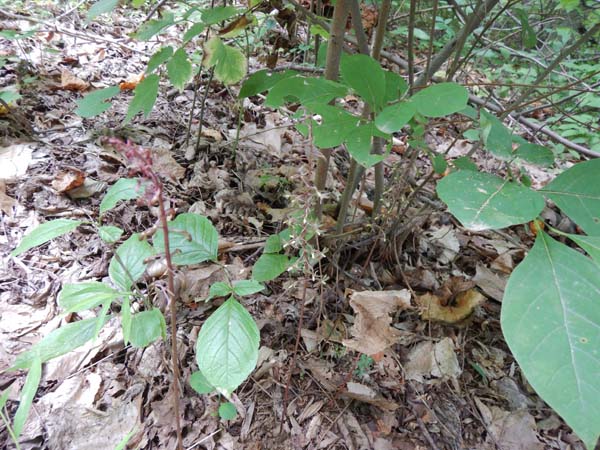
The habitat includes rich forests and oak-pine woods.
Fungal association during seed germination: One of the characteristics of all orchids includes the production of tiny seeds with embryos with little or no endosperm. The endosperm normally would provide food for the germinating seed otherwise photosynthesis would need to start right away.
However, orchids are different and they produce a structure called a protocorm that cannot make its own carbon energy but establishes a relationship with specific mycorrhizal fungi that will provide the carbon energy that it needs to grow. The fungi actually infect the protocorm and is eaten by the protocorm!
Fungal association during photosynthesis: While the plant has it's green leaves, studies have shown that the cranefly orchid still has fungal associations in its roots but with different fungi. These fungi still provide carbon energy to supplement the photosynthesis with amounts varing depending on growing conditions.
Note that the 'normal' fungal relationships with plants other than orchids is opposite for the carbon energy. That is, the plants normally provide carbon energy to the fungi in return for minerals and other nutrients.
Text by Millie Ling and all photos by Hubert & Millie Ling. Photos: Flowers - August: Sourland Mountains, NJ; Gorges State Park and other locations in the western mountains of North Carolina. Photos: Leaves - April - Sourland Mountains.
Additional information / References
Additional information / references:
- The USDA website shows Tipularia discolor distribution in the US and other information: https://plants.sc.egov.usda.gov/home/plantProfile?symbol=TIDI
- The Explorer at NatureServe shows Tipularia discolor distribution and rarity in the US and other information: https://explorer.natureserve.org/Taxon/ELEMENT_GLOBAL.2.157792/Tipularia_discolor.
- The Pollination Biology of North American Orchids: Volume 2 Stoutamire 1978 Tipularia discolor The Pollination Biology of North American Orchids: Volume 2 Stoutamire 1978 Tipularia discolor
- www.eFloras.org: Flora of North America http://efloras.org/florataxon.aspx?flora_id=1&taxon_id=220013573
- The Dynamics of Flowering and Fruit Production in Tipularia Discolor and Liparis Lilifolia, Whigham & O'Neil 1991 https://repository.si.edu/bitstream/handle/10088/18419/serc_whigham_oneill_1991.pdf?sequence=1&isAllowed=y
- Seedling Ecology and Evolution. Specialized seedling strategies II: orchids, bromeliads, carnivorousplants, and parasites Dennis F. Whigham, Melissa K. McCormick,and John P. O’Neill https://repository.si.edu/bitstream/handle/10088/18337/serc_seedling_chapter.pdf?sequence=1
- Phenology of roots and mycorrhiza in orchid species differing in phototrophic strategy Hanne N. Rasmussen1,2 and Dennis F. Whigham1 https://repository.si.edu/bitstream/handle/10088/2966/Rasmussen_Whigham_2002.pdf?sequence=1&isAllowed=y